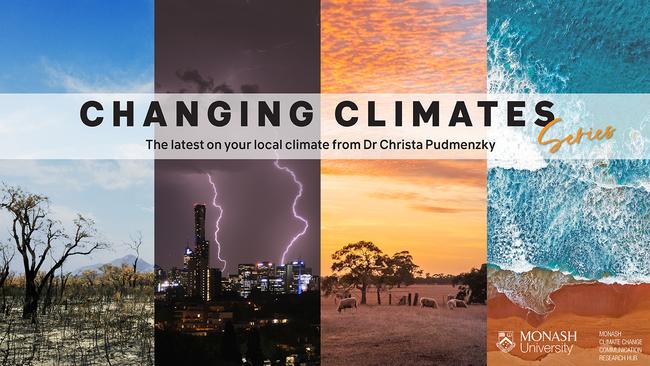Powering Aussie homes towards an electrified future
It's time to take the foot off the gas and electrify. Host of South Burnett's Changing Climates series, Dr Christa Pudmenzky, explains the benefits for our pockets and planet.

Hyperlocal
Don't miss out on the headlines from Hyperlocal. Followed categories will be added to My News.
Right now, Aussies have the opportunity to tap into the best two-for-one deal they will likely ever see.
This deal tackles two interlinked crises – the cost of living and our rapidly warming climate – and comes in the form of household electrification.
In short, electrification is the process of switching gas-guzzling appliances like stoves and gas heaters for electric alternatives.
But why is going electric the budget-friendly choice?
Since 2012, gas prices have risen almost twice as fast as electricity.
Additionally, Aussie households currently spend over a billion dollars a year in gas connection fees, meaning gas appliances burn holes in our wallets before we even turn them on.
Electrical appliances, on the other hand, need less energy to perform the same job, making them much cheaper to run.
For example, a split system electric heater is three times more efficient than a gas one.
And, while many of us swear by fiery gas stoves, it turns out induction ones are actually more energy efficient for cooking too.
So, electric appliances continue to be the clear winners, especially when it comes to efficiency.
The financial benefits also extend beyond the four walls of a single home.
Increased efficiency helps lower energy demand across the community and reduces power prices for consumers.
This is especially important for low-income earners who often live in lower quality housing with old, energy intensive gas appliances.
The efficiency advantage becomes even more beneficial when we consider Australia's world-leading uptake of rooftop solar and the growth of wind energy.
By combining the cheapest energy sources on earth with the most energy-conscious electric appliances, Aussies have the potential to enjoy the lowest possible energy bills.

Clean, green, electrified machine
Electrification also has perks for the planet.
In fact, it is the key way we can continue living our rapidly developing lives while also limiting emissions and combating climate change.
Let's take a look at why.
So-called 'natural' gas is a damaging fossil fuel mostly made up of methane.
Methane is up to 80 times more potent over a 20-year period than carbon dioxide, and has accounted for around 30 per cent of global warming since pre-industrial times.
We're feeling the impacts of these emissions here in South Burnett, with Queensland now experiencing around three more unusually warm February nights than it did in the 1970s.

In contrast, the ability to tap into our abundant, cheap, renewable energy resources means electrified households can stay clean and green.
The renewables industry also has plenty of room to grow – after all we are the sunburnt country with endless, windy coastlines.
In fact, using just two per cent of Australia's enormous landmass for wind and solar could produce enough power for around 1.2 billion homes – around 100 times the number of homes we have now.
So, where do we begin?
While electrification is already well underway, it will be no easy feat.
For starters, over 13 million residential gas appliances need replacing.
Achieving this will require the recruitment and training of a mammoth workforce, particularly to address current shortages of key trades like plumbers and sparkies.
The energy network itself will also be in for some changes to help cope with increased supply needs by households previously using gas.
This will rely on a coordinated plan for transitioning households so regulators, investors and planners know exactly how much energy is needed and where.
And finally, it is important that even our most vulnerable communities have access to the benefits of residential electrification.
Meeting all of these needs will require a cohesive, national plan that streamlines policies across states and local and federal governments.
To kickstart this process, a senate inquiry into residential electrification was launched last year, seeking formal public input.
Overwhelmingly, these submissions focussed on accessibility, equity, training, and incentives.
For example, the submission by Rewiring Australia recommends updates to the National Construction Code to ban new gas connections and support the electrification of apartment buildings.
They also propose energy performance standards for rentals, tax write-offs for landlords electrifying rental properties, education and training, and electrification of all social housing by 2030.
Recommendations put forward by the Climate Council to the same inquiry include supporting Aussies to electrify through zero-interest loans and direct upgrades for low income households.
As energy consumers, a great place to start is Rewiring Australia where you can see what household electrification might look like for you.
The Monash Climate Change Communication Research Hub's 'Switching On' report can also be used to learn about programs and initiatives already available in Queensland while you keep tabs on the senate inquiry.
Unhooking gas and plugging in environmentally friendly electric appliances will save hard-earned pennies and put Australia on track to a calmer climate.
Let's hear from your local community

Want more information on how your climate is changing? Check out the last article in this series.
Dr Christa Pudmenzky is a climate scientist at the University of Southern Queensland.
This column is part of a collaboration between Monash University and News Corp to deliver hyperlocal weather and climate information.

